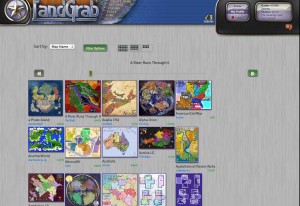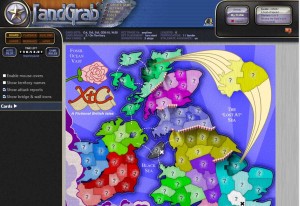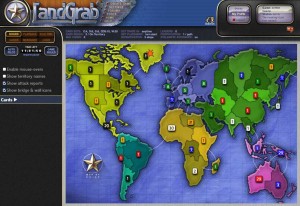LandGrab.net is a Risk playing site that has been around longer than anyone. I interviewed the developer, Desau to see what makes it tick.
1. LandGrab has been going strong for quite a long time. When did it start are what was your impetus to create an online Risk site?
Desau: LandGrab was born from an earlier private project I developed to play Risk with some friends back in California while I was living abroad, in France. That project started in 1997 and was used privately be a small group of my friends for a few years. That group of friends started growing until the old system really wasn’t maintainable and usable by the larger user-base. I started thinking of remaking it for a larger (public) audience around 2002-2003, then actually started writing the code in 2004. LandGrab was released publicly in August of 2005.
2 LandGrab has many features which are found no where else in the Risk playing world. Which features do you think make LandGrab special and how did you come up with them?
Desau: Yeah — I think just that point sets it apart. It’s sort of the “kitchen-sink” variant on the net. There are a number of really good sites out there, but I’ve always tried to make LandGrab the one place where you can find “your” rules. When I was growing up playing the board game, we all had our own house rules. I played in a number of circles of friends, and a number of different houses. Each house had its own set of rules .. and they seemed to morph from game night to game night. So I thought it would be imperative to allow the game creator to set up the rules however he or she wanted them played.
Recently, I added “Bridges and Walls”, which allow the players to control game borders as the game is played, by devoting soldiers to become engineers for a few turns to “build” bridges or walls. I don’t think I’ve seen this anywhere else, so I consider that one a LandGrab-only setting. I came up with that idea, as I have most, by just playing the game. I still love to play it, and I’m always in at least 20 active games at any given time. I was playing a game and thought to myself - “it would be great if there was a wall here, so I didn’t have to defend this border anymore …”
3. LandGrab has tons of customizable game settings. You can adjust the cards, armies, and over all game type. How do you as a developer decide what to put in and what to leave out? What are some of the most and least popular settings and have any of them surprised you?

Desaeu: I try to let the user-base drive this. If I see a particular feature is requested a lot, I’ll probably give it more thought than one that isn’t. Beyond that, it’s whatever I think would be fun and cool. More about this in question #8, but since this is a hobby for me, I write code that interests me and keeps me engaged.
Most popular, which surprised me, was realtime. I never expected so many people would be willing and excited to sit down for 3+ hours and play a full game with total strangers. Realtime games on LandGrab are much more popular that I had originally thought. As for rule settings, the “area-based reinforcements” has been a bit of a dud.. it may get deleted at some point.
4. LandGrab allows you to adjust the play style of AI (computer) players as well as change inactive players to computer players (Borgify). Were computer players part of LG from the beginning or were they created out of need?
Desau: They were there from the very beginning. That was actually part of a senior project for my BS in Computer Science. This was pre-LandGrab, but my original project (discussed in question #1) had computer AI as a research project. I just ported and improved some of that original code for LandGrab, then it because a natural fit for people who timeout.
5. For those who may be familiar with computer players on the official Risk game on Pogo, or on Lux Delux, how would you say your AI players stack up against the competition? How much development went into creating and testing their AI?
Desau: I’ll be the first to admit that the AI on LandGrab is pretty bad. There are times when it can overwhelm you if you don’t pay attention to it, but it’s quite predictable, and doesn’t really think very far ahead, or have a strong decision tree.
6. Some sites have a tightly controlled map creation process, some are more open. There are pro’s and con’s to both. Why did LG go with a more open process and how has that worked out? If you had to pick a favorite map, which would it be, and why?
Desau: Yeah - I’d say it worked out. And, I agree that there are pros and cons to each method. Having a controlled process certainly weeds out bad maps, but I believe that’s the job of the map choosing UI. That’s why I have a list of endorsed maps — those are the ones that most people see and choose from. However, if I want to make a silly map to play with my friends for 1 night, why not? It’s all about letting the users do what they want .. as long as it doesn’t hurt other players.
7. LandGrabs forum community has almost a 100,000 posts. What are some aspects of LG’s community that make it a success?
Desau: Not really sure. I tried to keep it easy to access and somewhat integrated (although not nearly as much as Conquer Club). I think the game just lends itself to socializing.. so that part needs to be there. Obviously having some regulars around with their well-known personalities helps.
8. Is it difficult to be a single person development team? How do you appease the many users and the growing TODO list? Is LG a full time gig for you?

Desau: Well — it’s difficult to get a lot of stuff done quickly, but it’s easy to make decisions :)
If you’ve seen the TODO list on LandGrab, you’ve seen that you can vote for items. This certainly helps me to prioritize things. I also read the forums regularly to keep a pulse on what’s working and what isn’t. High priority bugs (that hit a lot of people) are usually my number 1 concern. After a major release, I’ll just spend time doing nothing but bug fixing for a while, until things stabilize. After that, I try to find features that a lot of people are asking for, then mix in some stuff of my own creation. I’ve got another admin (foist) who is a great help in bouncing ideas off, and he’s an amazing artist — most of the graphics that you see on LandGrab are from him. When doing development on large new features, I’ll usually consult him to hash out how something should work.
Full time gig - no.. never has been. It’s always just been a fun hobby of mine. I currently work at a pretty fast-paced startup, and I’ve now got two kids and a wife, so LandGrab really doesn’t get nearly as much time as it used to. It’s never made a ton of money, I’ve always done it because it’s a good outlet for creative design and development for me, and I just love to play the game.
9. Not many Risk sites provide a public API. Are there examples of people using it in interesting ways?
Desau: One of the users made a tournament manager which allows people to create tournament games and monitor the progress. That’s probably the biggest project that’s come out of it. I’ll admit that I’m not really happy with how the API works. I wrote it using SOAP when the SOAP vs. REST war hadn’t been won by REST. I have dreams of redoing it all in a much simpler RESTful design at some point, opening it up to a broader base.
10. LG has monthly and yearly premium accounts like many other sites, but LG also uses a coin based marketplace system. This seems a little confusing to me. How do the coins fit into the membership model?

Desau: Yes - this has confused a number of people, and it needs to be smoothed out a bit. Memberships were there before the Marketplace / Coins came along, so when I implemented the Marketplace and Coins, I left the old membership avenue in place.. you can purchase a membership using a credit card, paypal or google checkout the same as always.
However, you also have a new method of using “LandGrab Coins”. The Coins can also be used for other things, such as gaming tokens - which allow you to rejoin games, or add another realtime game, etc.
Coins can be earned by playing games and unlocking achievements. You can also purchase coins (using the aforementioned methods of paypal & google checkout), and you can also earn coins using various ad-based offers.
11. From talking with other developers, it seems that a major thing they struggle with is marketing and getting users. LG currently has over 70k signups. Is this something you have struggled with and do you have an tips for what has worked best?
Desau: I haven’t really marketed it (at least not well). It’s mostly spread by word of mouth and a few review sites. I do spend a very small amount of money on a google ad campaign, but it drives very little traffic. Since it’s a hobby site for me, I don’t really care how fast it grows, although it’s nice to have a steady flow of good opponents to play, so I like to keep it active.
12. What are some general tips to help new LG players not get slaughtered and perhaps win a few points in their first few games.
Desau: :) I’d suggest starting with a computer game. Just start a game with 3 or 4 computer players so you can get used to the interface.
After that, try creating a few games so you know what type of game you’re playing. If you decide to join a game instead, as you’ve said, there are a myriad of choices, so you need to read the rules screen carefully.
I’d suggest creating your first few games with settings you know. Perhaps leave out the leaders, fortresses and capitals. Just set the cards and armies to something you’re familiar with, then play a game with 4 or 5 opponents. I’d also suggest not doing realtime to start.
13. Did you expect LG to go on for this long? Where do you see LG in the future, say 2-3 years?
Desau: I really had no expectations for it. Perhaps if it were a business, I’d have come up with a growth projection .. Perhaps if my day job is wildly successful, and I find myself with a lot of money and time, I’ll spend some of it on LandGrab to turn it into a business. But until then I’ll keep playing it and adding features and fixing bugs to keep the users happy.
In 2-3 years? I’ve got a few ideas that I’d like to implement — more things to spend coins on, more things to set it apart from the other sites. You’ll just have to wait and see :)
Thanks Desau, make sure you check out
LandGrab.net net today!
 Desaeu: I try to let the user-base drive this. If I see a particular feature is requested a lot, I’ll probably give it more thought than one that isn’t. Beyond that, it’s whatever I think would be fun and cool. More about this in question #8, but since this is a hobby for me, I write code that interests me and keeps me engaged.
Desaeu: I try to let the user-base drive this. If I see a particular feature is requested a lot, I’ll probably give it more thought than one that isn’t. Beyond that, it’s whatever I think would be fun and cool. More about this in question #8, but since this is a hobby for me, I write code that interests me and keeps me engaged. Desau: Yes - this has confused a number of people, and it needs to be smoothed out a bit. Memberships were there before the Marketplace / Coins came along, so when I implemented the Marketplace and Coins, I left the old membership avenue in place.. you can purchase a membership using a credit card, paypal or google checkout the same as always.
Desau: Yes - this has confused a number of people, and it needs to be smoothed out a bit. Memberships were there before the Marketplace / Coins came along, so when I implemented the Marketplace and Coins, I left the old membership avenue in place.. you can purchase a membership using a credit card, paypal or google checkout the same as always.
